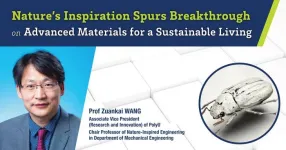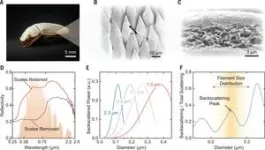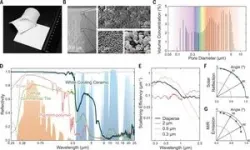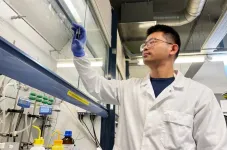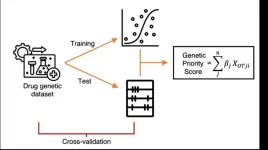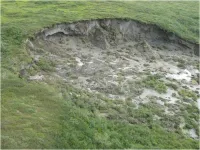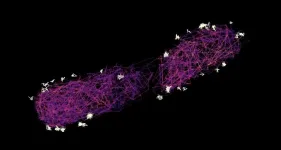Scientific researchers draw inspiration from nature’s brilliance as they seek to develop transformative solutions to unresolved challenges. Prof. WANG Zuankai, Associate Vice President (Research and Innovation) and Chair Professor of the Department of Mechanical Engineering of The Hong Kong Polytechnic University (PolyU), has meticulously explored the intricacies of nature and made remarkable findings with very significant real-world applications. His recently published research on cooling ceramic successfully translates novel discovery into sustainable applications.
Findings from his research project “Hierarchically structured passive radiative cooling ceramic with high solar reflectivity” were published in the journal Science. Together with Prof. Christopher CHAO, Vice President (Research and Innovation), Chair Professor of Thermal and Environmental Engineering of PolyU and co-author of the paper, Prof. Wang collaborated with a research team from the City University of Hong Kong on this innovation.
With unwavering commitment to transformative research, the research team led by Prof. Chao and Prof. Wang has developed a passive radiative cooling ceramic (cooling ceramic) that can achieve highly efficient light scattering and a near-perfect solar reflectivity of 99.6%. This passive radiative cooling material demonstrates promising energy-saving potential with weather resistance and high mechanic strength, reducing the cooling demand of an indoor environment.
“Our work on cooling ceramic exemplifies the power of learning from nature. It addresses a significant research gap in passive radiative cooling, specifically high solar reflectivity. Taking inspiration from the bio-whiteness observed in the whitest beetle, the researchers optimised the design of the scattering system, leading to a significant increase in solar reflectivity,” said Prof. Wang.
Beetle-inspired material to achieve 99.6% solar reflectivity
This innovation was derived from the intricate biological structure of Cyphochilus, the whitest known beetle. Based on investigation of the scattering system found in the beetle's scales, the cooling ceramic was engineered with a hierarchically porous structure. This nature-inspired system is easily fabricated and boasts excellent daytime cooling performance, thus reducing energy consumption for indoor cooling.
“Nature offers us an abundance of intricate designs, efficient systems and sustainable solutions that have evolved over millions of years. Through careful study of these natural phenomena, we can uncover innovative ideas and principles that can be translated into practical applications,” said Prof. Wang.
This cooling ceramic also exemplifies Prof. Wang’s pioneering structured thermal amour (STA), which has the potential to enable efficient water cooling at ultra-high solid temperatures - an uncharted property. His previous research project, “Inhibiting the Leidenfrost effect above 1,000°C for sustained thermal cooling”, tackled the longstanding challenges posed by the Leidenfrost effect.
When the temperature surpasses the Leidenfrost point, a continuous vapour layer forms between a solid and a liquid, resulting in a decrease in heat transfer due to increased thermal resistance. Prof. Wang’s innovative STA holds the potential to implement efficient liquid cooling at extremely high temperatures.
First-time investigation into the Leidenfrost effect
In applications involving evaporative cooling, the interaction between water and surfaces at high temperatures is a critical yet frequently overlooked phenomenon. Therefore, the suppression of the Leidenfrost effect is a major milestone in the successful development of this cooling ceramic, in addition to the bio-inspired whiteness and high solar reflectivity.
The cooling ceramic exhibits super-hydrophilicity, enabling immediate droplet spreading and facilitating rapid impregnation of the droplets through its interconnected porous structure. As a result, the cooling ceramic inhibits the Leidenfrost effect at temperatures above 800°C during the evaporative cooling process.
“One of the key factors contributing to the success of the cooling ceramic is its hierarchical porous structure, akin to the porous membrane used in the STA design. It is this intricate structure that enables the ceramic to effectively draw in and evaporate liquid, thereby efficiently inhibiting the Leidenfrost effect,” said Prof. Wang.
It is the first time that the Leidenfrost effect has been investigated within the realm of passive radiative cooling materials. This novel exploration broadens the horizons of passive radiative cooling material design and also provides new insights for STA development and application.
The cooling ceramic’s ingenuity lies in its ability to achieve multiple functionalities through simple fabrication and manipulation. Its key features, including high weather resistance, mechanical robustness, the ability to depress the Leidenfrost effect, favorable recyclability and its colour, contribute to its practical applications in diverse scenarios and building constructions. With its suitability for commercialisation and long-term outdoor applications, it also possesses advantages in terms of cost-effectiveness, durability and versatility.
Nature inspires scientific discovery and drives the development of impactful solutions through new materials, devices and systems. This is also the vision of the Research Centre for Nature-Inspired Science and Engineering at PolyU, led by Prof. Wang. The Centre is envisioned as a dynamic hub for innovation and collaboration, leveraging nature’s brilliance to create transformative solutions for societal and environmental challenges.
“This cooling ceramic research breakthrough illustrates the practicality and versatility of our approach. The cooling ceramic not only exhibits exceptional cooling performance through its bio-inspired structure from the white beetle but also possess valuable features such as self-cleaning properties, robust mechanical strength and Leidenfrost effect depression. All these characteristics make it ready for real-world applications,” said Prof. Wang.
END
